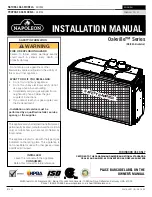
Page 4
www.enersys.com Publication No. US-FL-IOM-002 January 2007
2.3.2 Explosive
Gases
Batteries can generate gases which, when released, can explode, causing blindness and other
serious personal injury.
•
Always wear protective clothing and use the correct safety tools.
•
Eliminate any potential of sparks, flames or arcing.
•
Provide adequate ventilation. See Appendix.
IN CASE OF FIRE
: To extinguish a fire in a battery room containing lead acid batteries, use
CO2, foam, or dry chemical extinguishing media. Do NOT discharge the extinguisher directly
onto the battery. The resulting thermal shock may cause cracking of the battery case/cover.
SPECIAL PROCEDURES:
If batteries are on charge, shut off power. Use positive pressure, self-contained breathing
apparatus. Water applied to electrolyte generates heat and causes it to splatter. Wear acid-
resistant clothing.
TOXIC FUMES:
Burning plastic may cause toxic fumes. Leave area as soon as possible if toxic fumes are
present. Wear breathing apparatus if required to remain in the area.
2.3.3
Electrical Shocks and Burns
Multi-cell battery systems can attain high voltage and/or currents. Do NOT
touch uninsulated batteries, connectors or terminals. To prevent serious
electrical burns and shock, use EXTREME CAUTION when working
with the system.
•
Always wear protective clothing and use nonconductive or insulated tools when
working with ANY battery system.
•
Remove all jewelry that could produce a short circuit.
BEFORE
working on the system:
1.
Disconnect ALL loads and power sources to the battery. Use appropriate lockout/tagout
procedures.
2.
If working on an assembled battery system, sectionalize (interrupt the battery in sections)
into safe working voltage levels.
3.
Check the battery system grounding. Grounding of the battery system is NOT
recommended. However, grounding of the rack is recommended.
Содержание PowerSafe Data Safe
Страница 8: ......













































